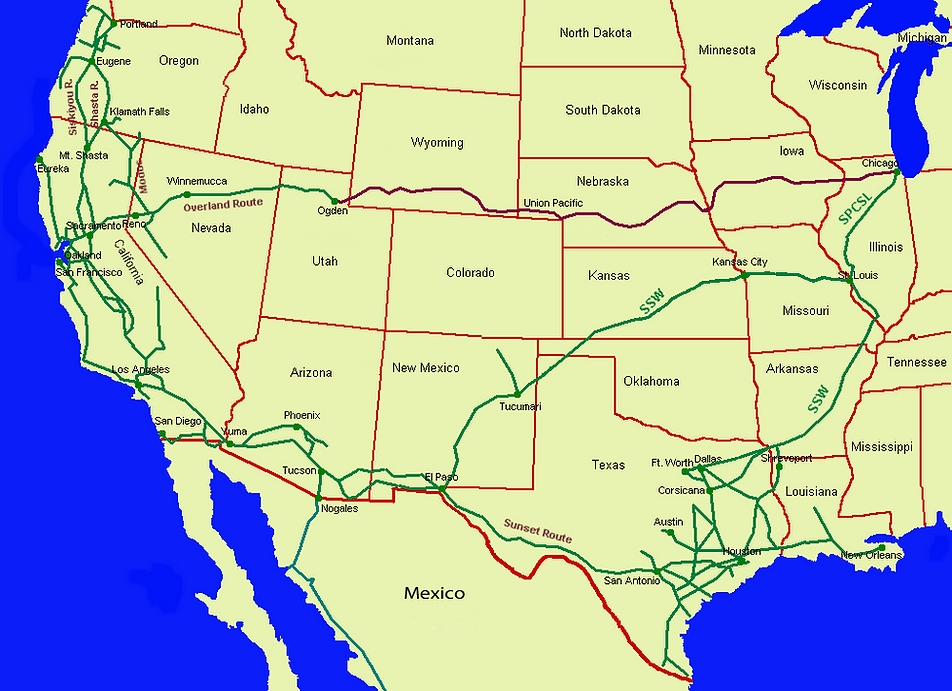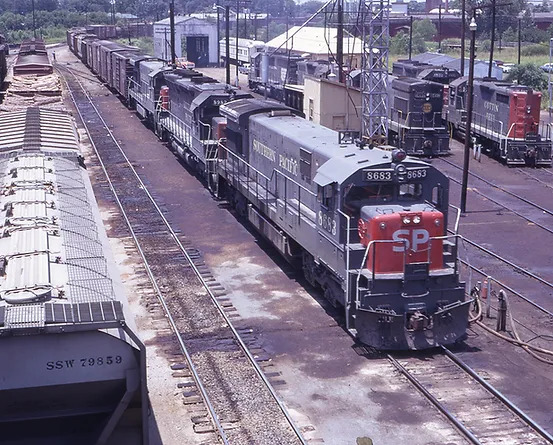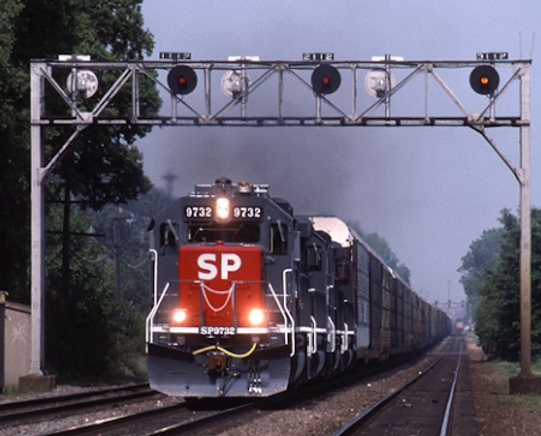THE SOUTHERN PACIFIC STORY
The story of the Southern Pacific is a legacy rich with economic, transportation, political, legal, and engineering influence in America west of the Mississippi River. All these factors created an environment for the settlement of migrants and explosion of employment in the Western United States that provided skilled job and educational opportunities for hundreds of thousands of families during the company’s existence.
The Southern Pacific’s earliest roots in railroading can be traced to Texas in the decade leading up to the Civil War. An early railroad known as the Buffalo Bayou, Brazos & Colorado operated its trains in Texas in 1853, three years before the Sacramento Valley Railroad operated its first train in California. Both railroad companies would eventually become part of the Southern Pacific Empire, a system which ultimately spanned thirteen states primarily west of the Mississippi River.

What quickly became America’s first land holding company, the Southern Pacific Railroad (Southern Pacific) was incorporated in 1865 and would later lease the Central Pacific Railroad (Central Pacific). Central Pacific began construction of America’s First Transcontinental Railroad in Sacramento, California in 1863. The Central Pacific built eastward over rugged mountains of the Sierra range in Eastern California for five years before racing across the deserts of Nevada and Utah to meet the Union Pacific Railroad (Union Pacific) on May 10, 1869. The driving of the Golden Spike at Promontory linked east and west, signaling the beginning of the end to America’s quest for Manifest Destiny.
Southern Pacific quickly built further south under its own name, reaching Bakersfield, California by 1874. By this time, the company had already completed its first home-built steam locomotive in 1873, putting Southern Pacific on the map as the only major builder of locomotives in the west. By 1877, Southern Pacific had constructed to trackage to Yuma, Arizona and 1881, it would arrive in El Paso, Texas.
Southern Pacific’s strategy for gaining railroad influence in Texas and Louisiana was to purchase control of previously-established operating railroads. This included lines that connected El Paso, Texas with New Orleans, Louisiana. Texas state laws required separate legal entities operating railroads in that state and in response Southern Pacific would operate the Texas and New Orleans Railroad (T&NO). Commonly referred to as the T&L Lines, SP’s operations east of El Paso spanned 3,713 miles of mainline trackage at its height.
The Oregon and California Railroad had built north of Roseville, California and south from Portland, Oregon to complete a line through the Siskiyou Mountains of Southern Oregon in 1887. This extended Southern Pacific operations to the Pacific Northwest, creating a large traffic of forest products moving to California and other points in the western United States where communities were rapidly growing.
In 1901, the Union Pacific Railroad gained control of the Southern Pacific following the death of Collis Huntington, the last surviving “Associate” who founded and managed the Central Pacific and Southern Pacific, respectively. During this era known as “Harriman Control,” Southern Pacific and Union Pacific standardized operations and equipment purchases. They also created a jointly-owned venture called the Pacific Fruit Express Company (PFE). PFE operated the largest fleet of refrigerated freight cars on earth and transported fresh fruit and vegetables from western markets to eastern consumers hungry for novel perishables such as strawberries and oranges.
After the US Government required SP and UP to split up in 1913 over antitrust concerns, Southern Pacific’s growth in the 20th Century came mostly from building or acquiring subsidiary companies. In 1907, the Northwestern Pacific Railroad was formed to consolidate many railroad companies in operation north of San Francisco and would ultimately build 271 miles north to Eureka, California. Although Southern Pacific sold its final interests in the company in 1993, as of 2021, the Northwestern Pacific remains the last former Southern Pacific entity still providing rail transportation services under its original name.

The Cotton Belt Yard in Texarkana on July 4, 1973. Photo by Ed Chapman.
Corporate leases and vestiges of predecessor companies were eliminated after WWII, and Southern Pacific’s rail assets in Mexico were sold to the Mexican Government in 1951. With little fanfare in 1959, Central Pacific’s lease to the Southern Pacific was discontinued, folding the pioneer of western railroading into its parent company. The T&NO, which operated in Texas east of El Paso and in Louisiana, was merged into Southern Pacific in 1961, but was essentially managed from Houston for several decades following the consolidation.
In 1969, Southern Pacific Transportation Company (SPTC) absorbed all the previous corporate names of the railroad.
After failed merger attempts with the Atchison Topeka and Santa Fe Railroad in the 1980s, SPTC was sold to Rio Grande Industries, the parent company of the Denver and Rio Grande Western Railroad. Rio Grande would operate as a subsidiary of the Southern Pacific until 1996.

The final frontier for the Southern Pacific was acquisition of the Southern Pacific Chicago St. Louis Corp., proudly known as SPCSL. In November 1989, Rio Grande Industries purchased the St. Louis to Chicago portion of the failed Chicago, Missouri and Western Railroad. This “Chicago Gateway” initiative provided Southern Pacific direct access to Chicago allowing it to participate in the hub of rail commerce between western railroads and northeast markets. Although Southern Pacific established a successful presence in Chicago, it never owned more than 2,000 feet of trackage, and it depended on the trackage of its partners in the Chicago area for the origination and termination its trains, as well for them to provide services such as fueling its locomotives and performing initial air-brake tests.
Union Pacific announced in 1995 that it intended to merge with Southern Pacific and on September 11, 1996, Union Pacific control of Southern Pacific was completed. On February 1, 1997, Southern Pacific Transportation Company and the Union Pacific Railroad were formally merged. Union Pacific was merged into SPTC and the name was simultaneously changed from SPTC to the new Union Pacific Railroad.
